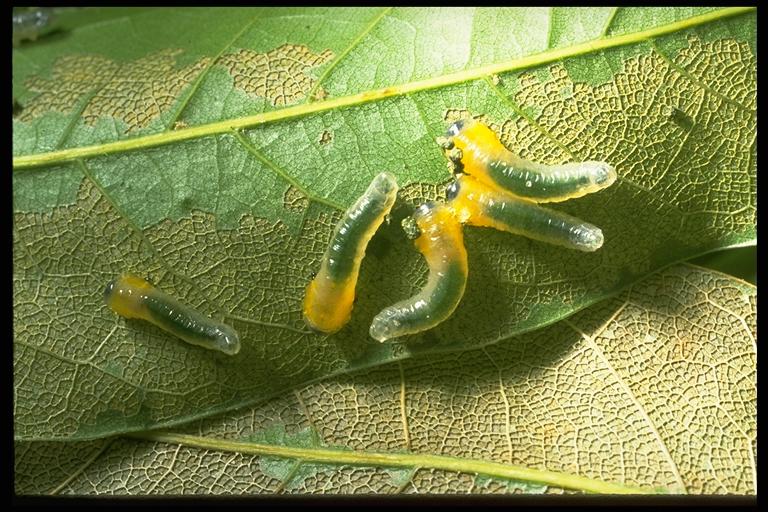
A sawfly (Hymenoptera: Cimbicidae, Diprionidae or Tenthredinidae) larvae on oak. Photo by Drees.
Common Name: Sawfly
Scientific Name: Varies
Order: Hymenoptera
Description: These primitive wasps are not flies (Diptera), because they have two pairs of wings. Larval stages are caterpillar-like, with a well developed head capsule and three pairs of true legs behind the head and a hairless body. Unlike caterpillars (Lepidoptera larvae), fleshy “false legs” (prolegs) occur on at least the second through sixth abdominal segments and the bottoms of these prolegs lack rows of tiny hooks (crochets) found only on caterpillars. Some sawfly larvae are slug-like, appearing slimy, non-segmented and translucent, greenish to black, while others appear wax-covered in some of their developmental stages. The adult elm sawfly, Cimbex americana Leach (Cimbicidae) is 3/4 to 1 inch long, dark blue, parallel-sided and females have four small yellow spots on each side of the abdomen. The full grown elm sawfly larva is 1-½ inches long, greenish-yellow with a black stripe down the center of the back. Conifer sawflies (Diprionidae) have somewhat more compact bodies and the antennae of females are feathery (pectinate or bipectinate). Common sawflies (Tenthredinidae) are wasp-like, often brightly colored and up to 3/4 inch long. Larvae can change in appearance and coloration through developmental stages.
Life Cycle: Life cycles vary by species, but generally they overwinter as a pre-pupa in a cocoon in the ground or other protected place, pupating in the spring. In early summer, adults lay eggs in or on plant tissue. Larvae develop through several stages (up to 6 instars) before pupating, producing one generation per year. Some species have several generations annually.
Habitat, Food Source(s), Damage: Mouthparts are for chewing. Most sawflies are somewhat host-specific. The elm sawfly feeds on elm and willow. Conifer sawflies (such as the loblolly pine sawfly, Neodiprion taedae linearis Ross) can occasionally cause serious injury to pines and other evergreens by feeding on foliage, tunneling into buds or boring into shoots. Larvae of the blackheaded ash sawfly, Tethida cordigera (Beauvois), and brownheaded ash sawfly, Tomostethus multicinctus (Rohwer), feed on red and white ash. Common sawfly larvae feed together (gregariously) and may hold their abdomens coiled over the edge of the leaf. On broadleaved tree leaves, larvae usually feed on the underside of the leaf. On oaks, Caliroa spp. larvae skeletonize leaves, while on pecan sawfly larvae produce round holes of various sizes in leaf tissue. Some species are leaf rollers, web formers, leaf skeletonizers, leaf miners or cause plant galls. Adults can be found on flowers.
Pest Status: Adults are rarely seen and do not sting. They are called sawflies because females of most species have a saw-like structure on the tip of their abdomens used to inject eggs into plant tissue. Larvae feed of the leaves of plants and can occasionally become numerous enough to cause injury to some trees; medically harmless.
For additional information, contact your local Texas A&M AgriLife Extension Service agent or search for other state Extension offices.
Literature: Borror et al. 1989; Johnson & Lyon 1988.